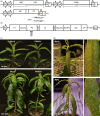An efficient viral vector for functional genomic studies of Prunus fruit trees and its induced resistance to Plum pox virus via silencing of a host factor gene
- PMID: 27565765
- PMCID: PMC5316922
- DOI: 10.1111/pbi.12629
An efficient viral vector for functional genomic studies of Prunus fruit trees and its induced resistance to Plum pox virus via silencing of a host factor gene
Abstract
RNA silencing is a powerful technology for molecular characterization of gene functions in plants. A commonly used approach to the induction of RNA silencing is through genetic transformation. A potent alternative is to use a modified viral vector for virus-induced gene silencing (VIGS) to degrade RNA molecules sharing similar nucleotide sequence. Unfortunately, genomic studies in many allogamous woody perennials such as peach are severely hindered because they have a long juvenile period and are recalcitrant to genetic transformation. Here, we report the development of a viral vector derived from Prunus necrotic ringspot virus (PNRSV), a widespread fruit tree virus that is endemic in all Prunus fruit production countries and regions in the world. We show that the modified PNRSV vector, harbouring the sense-orientated target gene sequence of 100-200 bp in length in genomic RNA3, could efficiently trigger the silencing of a transgene or an endogenous gene in the model plant Nicotiana benthamiana. We further demonstrate that the PNRSV-based vector could be manipulated to silence endogenous genes in peach such as eukaryotic translation initiation factor 4E isoform (eIF(iso)4E), a host factor of many potyviruses including Plum pox virus (PPV). Moreover, the eIF(iso)4E-knocked down peach plants were resistant to PPV. This work opens a potential avenue for the control of virus diseases in perennial trees via viral vector-mediated silencing of host factors, and the PNRSV vector may serve as a powerful molecular tool for functional genomic studies of Prunus fruit trees.
Keywords: Prunus necrotic ringspot virus; eukaryotic translation initiation factor 4E; functional genomics; sharka; viral vector; virus-induced gene silencing.
© 2016 The Authors. Plant Biotechnology Journal published by Society for Experimental Biology and The Association of Applied Biologists and John Wiley & Sons Ltd.
Figures






Similar articles
-
Silencing of the host factor eIF(iso)4E gene confers plum pox virus resistance in plum.PLoS One. 2013;8(1):e50627. doi: 10.1371/journal.pone.0050627. Epub 2013 Jan 28. PLoS One. 2013. PMID: 23382802 Free PMC article.
-
Effect of Gene Silencing of Translation Initiation Factors eIF(iso)4G and eIF(iso)4E on Sour Cherry Rootstock Resistance to Sharka Disease.Int J Mol Sci. 2022 Dec 26;24(1):360. doi: 10.3390/ijms24010360. Int J Mol Sci. 2022. PMID: 36613806 Free PMC article.
-
Silencing of one copy of the translation initiation factor eIFiso4G in Japanese plum (Prunus salicina) impacts susceptibility to Plum pox virus (PPV) and small RNA production.BMC Plant Biol. 2019 Oct 22;19(1):440. doi: 10.1186/s12870-019-2047-9. BMC Plant Biol. 2019. PMID: 31640557 Free PMC article.
-
Genetically engineered resistance to Plum pox virus infection in herbaceous and stone fruit hosts.GM Crops. 2011 Jan-Mar;2(1):24-33. doi: 10.4161/gmcr.2.1.15096. GM Crops. 2011. PMID: 21844696 Review.
-
Plum pox virus and sharka: a model potyvirus and a major disease.Mol Plant Pathol. 2014 Apr;15(3):226-41. doi: 10.1111/mpp.12083. Epub 2014 Jan 8. Mol Plant Pathol. 2014. PMID: 24102673 Free PMC article. Review.
Cited by
-
A Newly Identified Virus in the Family Potyviridae Encodes Two Leader Cysteine Proteases in Tandem That Evolved Contrasting RNA Silencing Suppression Functions.J Virol. 2020 Dec 9;95(1):e01414-20. doi: 10.1128/JVI.01414-20. Print 2020 Dec 9. J Virol. 2020. PMID: 33055249 Free PMC article.
-
Genetic dissection of Sharka disease tolerance in peach (P. persica L. Batsch).BMC Plant Biol. 2017 Nov 3;17(1):192. doi: 10.1186/s12870-017-1117-0. BMC Plant Biol. 2017. PMID: 29100531 Free PMC article.
-
Bacillus velezensis HN-2: a potent antiviral agent against pepper veinal mottle virus.Front Plant Sci. 2024 Jul 10;15:1403202. doi: 10.3389/fpls.2024.1403202. eCollection 2024. Front Plant Sci. 2024. PMID: 39049860 Free PMC article.
-
A Zinc Finger Motif in the P1 N Terminus, Highly Conserved in a Subset of Potyviruses, Is Associated with the Host Range and Fitness of Telosma Mosaic Virus.J Virol. 2023 Feb 28;97(2):e0144422. doi: 10.1128/jvi.01444-22. Epub 2023 Jan 23. J Virol. 2023. PMID: 36688651 Free PMC article.
-
Molecular Identification of Prune Dwarf Virus (PDV) Infecting Sweet Cherry in Canada and Development of a PDV Full-Length Infectious cDNA Clone.Viruses. 2021 Oct 7;13(10):2025. doi: 10.3390/v13102025. Viruses. 2021. PMID: 34696454 Free PMC article.
References
-
- Agüero, J. , Ruiz‐Ruiz, S. , del Carmen Vives, M. , Velázquez, K. , Navarro, L. , Peña, L. , Moreno, P. et al. (2012) Development of viral vectors based on Citrus leaf blotch virus to express foreign proteins or analyze gene function in citrus plants. Mol. Plant Microbe Interact. 25, 1326–1337. - PubMed
-
- Agüero, J. , del Carmen Vives, M. , Velázquez, K. , Pina, J.A. , Navarro, L. , Moreno, P. and Guerri, J. (2014) Effectiveness of gene silencing induced by viral vectors based on Citrus leaf blotch virus is different in Nicotiana benthamiana and citrus plants. Virology, 460, 154–164. - PubMed
-
- Aparicio, F. , Vilar, M. , Perez‐Payá, E. and Pallás, V. (2003) The coat protein of prunus necrotic ringspot virus specifically binds to and regulates the conformation of its genomic RNA. Virology, 313, 213–223. - PubMed
-
- Atanasoff, D. (1933) Plum pox. A new virus disease. Ann. L'Univ. Sofia, 11, 49–69.
-
- Bai, S. , Tuan, P.A. , Tatsuki, M. , Yaegaki, H. , Ohmiya, A. , Yamamizo, C. and Moriguchi, T. (2016) Knockdown of carotenoid cleavage dioxygenase 4 (CCD4) via virus‐induced gene silencing confers yellow coloration in peach fruit: evaluation of gene function related to fruit traits. Plant Mol. Biol. Rep. 34, 257–264.
Publication types
MeSH terms
Substances
Associated data
- Actions
- Actions
LinkOut - more resources
Full Text Sources
Other Literature Sources
Research Materials

